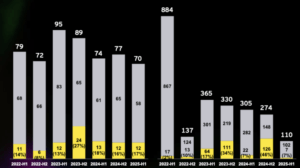The biggest crypto trends in 2024: Solana, Cardano & Polygon

Ed Prinz is co-founder and CEO of Loob.io , a digital marketplace for blockchain assets, and chairman of DLT Austria , a non-profit organization promoting blockchain technology. This is the second part of his three-part series on “Crypto Trends 2024”. Part I of the crypto trends for 2024 can be read here, part II is available here.
In this article, we will focus on the blockchain technologies from Solana, Polygon and Cardano, which could make impressive progress in 2024. These platforms are at the forefront of innovation while maintaining their focus on scalability, interoperability and decentralization. Their growing importance as key players in the dynamic world of crypto assets and distributed ledger technologies cannot be overlooked.
We take a look at the year 2024, which will be characterized by groundbreaking developments and innovations for the world of crypto assets. These could bring about profound changes in the way we do business, communicate and interact with each other.
Solana 2024: Pioneering work for the future of blockchain?
In 2023, Solana – a leading blockchain platform – experienced a period of remarkable growth and evolution. This growth has established the platform as a significant player in the world of crypto assets and laid a solid foundation for further developments in 2024. The platform is characterized by its innovative technology and increasing acceptance in the crypto community.
A standout feature of Solana is its strong and dedicated developer community. With over 2,500 developers actively contributing to the platform, Solana has established itself as an attractive ecosystem for blockchain developers. Also noteworthy is the high developer retention rate, which is over 50%. This high level of engagement underlines the attractiveness of the platform and its potential for continuous innovation.
Solana’s on-chain activity has also achieved impressive numbers. With daily transactions exceeding 40 million and an increase in the number of daily paid users, Solana has further solidified itself as a central network for crypto enthusiasts. These numbers reflect not only user trust in the platform but also the efficiency and scalability of the Solana network.
In blockchain technology, a key focus is on promoting decentralization and eliminating individual vulnerabilities. Platforms like Ethereum (ETH) encourage independent developers to develop their own client versions in different programming languages. This approach gives node operators the freedom to choose from a variety of client variants. This achieves greater diversity and flexibility in the choice of client.
One of the significant benefits of this diversity is that each client has a unique code base. This reduces the overall vulnerability of the network to bugs and attacks. It also reduces the risk of transaction finality by preventing a single client from manipulating blockchain transactions. Additionally, it allows developers to create applications in the programming languages they are most familiar with.
Due to the importance of client diversity, the Ethereum protocol has introduced penalty mechanisms such as inactivity leaks to discourage nodes from using the same client software. This is intended to promote the diversity and strength of the network.
In contrast, the Solana blockchain currently only has three validation clients in operation. These include the Solana Labs Client, written in the Rust programming language, the Jito-Solana Client, a fork of the Solana Labs Client, also in Rust, and the Sig Client, written in the Zig programming language. This limited number of clients means that Solana may not be as resilient to attacks as its main competitor Ethereum, which currently has around six different consensus clients and eight execution clients.
Additionally, Solana’s native client does not support sharding – a system that improves the scalability of the blockchain by spreading a load of transaction processing across multiple smaller shard chains at the same time.
However, in 2024, Solana, a rising star in the world of crypto assets, is preparing for significant developments. At the center of developments for 2024 is the announcement of new token expansions by the Solana developers. Developed in the first quarter in collaboration with major institutions, these extensions aim to increase the versatility of token creation. They simplify the creation process and offer high compatibility, strengthening Solana’s position as a token creation platform. The enhancements include features such as confidential transfers, transfer hooks, metadata pointers, and the creation of a more transparent and customizable token platform, making Solana even more attractive to developers and users.
Another significant development is the introduction of Firedancer, a redesign of Solana’s validator client. Firedancer promises optimization of the network, runtime, and consensus components and has already demonstrated over a million transactions per second per core in benchmarks. This innovation addresses bottlenecks and promises increased scalability, especially with future hardware improvements in mind. These and other validator clients further strengthen the resilience, stability, and security of the network.
Firedancer represents a novel high-performance validation software for Solana, developed in the C++ programming language. Created by Jump Crypto, a company specializing in Web3 infrastructures, Firedancer was designed to significantly improve Solana’s ability to process transactions and incorporate support for so-called sharding.
In a live demonstration in 2022, Firedancer impressively demonstrated that it can handle more than 1 million transactions per second. This performance far exceeds Solana’s current theoretical maximum of 50,000 transactions per second and is well above the transaction volume typically handled by leading payment processors such as Visa.
This increased performance is expected to strengthen Solana’s position as one of the leading Layer 1 blockchain and allow the network to compete with the leaders in the blockchain market. The project was announced back in 2022, and the live test network went live in October 2023.
In addition to its features, Firedancer offers Solana’s validation nodes an additional, fourth software option. This helps further reduce Solana’s vulnerability to software bugs, code vulnerability exploitation, and attacks.
Solana is poised for significant developments in 2024 that will further solidify its role in the world of crypto assets. By introducing new technologies and improving existing systems, the platform is continuously expanding its position. With a growing developer and user base as well as the launch of Firedancer, Solana is expected to achieve new heights and establish itself as a leading force in blockchain technology.
Cardano 2024: The Path to Blockchain Innovation and Interoperability
In 2024, Cardano, one of the leading blockchain platforms, is at a crucial turning point with several groundbreaking developments and innovations. Throughout 2023, Cardano has introduced key infrastructure components that lay the foundation for 2024 developments. These include the launch of Jed, the sidechain toolkit, Hydra, the Lace wallet, and other key elements. These achievements reflect Cardano’s continued development and maturity and point to 2024 marked with fewer but more significant milestones.
Hydra is an innovative Layer 2 scaling solution built for the Cardano ecosystem. Inspired by the mythological figure of the Hydra, this technology aims to significantly increase the processing capacity of transactions on the Cardano blockchain. In simple words: Hydra allows Cardano to process more transactions faster.
The main purpose of Hydra is to address the latency and low throughput challenges that Cardano has had to date. These improvements are critical to realizing Cardano’s goal of becoming the world’s leading decentralized blockchain and serving millions of users worldwide. The implementation of Hydra is intended to significantly expand Cardano’s ability to process transactions.
How Hydra works is based on so-called isomorphic state channels, which operate alongside the Cardano mainnet. The term “isomorphic” may sound technical, but it simply means that the off-chain protocol mirrors the on-chain protocol. These state channels are referred to as Hydra Heads. These heads process transactions off-chain, ensuring fast and efficient operations. This not only increases the speed of transactions but also ensures that the main chain remains unencumbered.
The horizontal scaling solution enables the Cardano network to grow sustainably. As demand and network growth increase, additional heads (state channels) can be added. In theory, this parallel processing capability is intended to ensure that Hydra can easily meet the increasing demands that come with Cardano’s growing adoption.
Additionally, Hydra nodes bypass the 20-second time limit for Cardano blocks. This means that independent state channels can process transactions outside the limitations of the main network.
The launch of Hydra aims to improve the scalability of the Cardano network by moving certain transactions to these off-chain state channels. This reduces the load on the main network and allows the network to grow horizontally.
Hydra is just one of many scaling solutions being discussed in the Cardano community and represents an important step toward increasing the performance and capacity of the Cardano network. This could make Cardano a more attractive platform for developers and companies looking to integrate blockchain technology into their systems.
Another important aspect for Cardano in 2024 is the launch of the Midnight Mainnet, which is currently in development. This innovation aims to connect Cardano to other chains in the crypto space, creating a kind of “super highway” for the blockchain world. The successful implementation of Midnight would significantly improve interoperability and collaboration between different blockchain networks.
Another important event for Cardano in 2024 is the launch of the Dust token, which could launch alongside the Midnight mainnet. This move could change the way stakeholders interact and are rewarded within the Cardano ecosystem.
Additionally, Cardano is expected to make progress in the areas of blockchain management and network utilization. Given the increasing load on the Cardano network, optimizing block size and efficiency will play an important role. This could mean improved network traffic handling and more efficient transaction processing.
Another significant step for Cardano in 2024 is achieving full decentralization. Cardano is moving towards on-chain governance. This move marks a significant milestone towards true decentralization and would place the governance of the network in the hands of the community. This underscores Cardano’s commitment to a community-driven future, where key decisions and development of the network are driven by users and developers themselves.
The developments in 2024 represent a period of consolidation and fine-tuning for Cardano. The platform, which has already established much of its infrastructure, is now focusing on optimizing its systems and strengthening the foundations for future growth and expansion. This strategy aims to establish Cardano not only as a leading blockchain platform but also as an ecosystem equipped to meet the challenges and opportunities of an increasingly digitalized and decentralized world.
Overall, Cardano is on the threshold of exciting times in 2024. With the continued development and adoption of new technologies, increasing decentralization, and strengthening community participation, Cardano is positioning itself as one of the leading platforms in the world of crypto assets and blockchain technology. This year is likely to have a significant impact on the future of Cardano and the broader blockchain landscape.
Polygon Developments 2024
The year 2024 marks a significant milestone in the evolution of Polygon, a leading platform in the blockchain ecosystem. Polygon has established itself as a key player in the world of decentralized applications (dApps) and smart contracts through innovation and strategic partnerships.
A key aspect of Polygon’s developments in 2024 is the ongoing implementation and improvement of the Polygon 2.0 strategy. This aims to create a seamless, scalable, and efficient network that redefines the boundaries of what is possible in blockchain technology. With Polygon 2.0, the platform has focused on creating an interoperable ecosystem where different blockchain networks can work together effectively. This approach facilitates a seamless user experience by reducing the fragmentation that often comes with using different blockchains.
Another key advance in 2024 is the introduction and integration of Polygon zkEVM (Zero-Knowledge Ethereum Virtual Machine). This technology enables greater scalability and efficiency by taking advantage of zero-knowledge proofs to process transactions faster and more cost-effectively without compromising security. This is especially important for developers who want to build powerful dApps without compromising on security.
Expanding and deepening partnerships is another focus for Polygon in 2024. By working with large companies and startups, Polygon has expanded its reach and influence. These collaborations range from integration with e-commerce platforms to supporting NFT marketplaces and DeFi applications. In particular, the partnership with major brands in retail and other industries underlines Polygon’s versatility and broad application possibilities.
Polygon has also made significant strides in the decentralized finance (DeFi) space. By providing robust infrastructure and advanced tools, Polygon has fostered the development of DeFi applications ranging from simple exchanges to complex financial products. These developments have helped Polygon become a preferred ecosystem for DeFi innovation, allowing applications and platforms in this space to flourish.
In the area of token economics, Polygon has taken significant steps to increase and stabilize the value of its native token, MATIC. Through careful adjustments in tokenomics and the implementation of combustion mechanisms, Polygon has created sustainable economics that appeal to both investors and users. These measures have helped to increase trust in the platform and increase its attractiveness as an investment destination.
Another notable advance from Polygon in 2024 is its increased focus on sustainability and environmental friendliness. Recognizing the growing importance of environmental concerns in the technology industry, Polygon has taken steps to reduce its environmental footprint. This includes the use of energy-efficient consensus mechanisms and participation in carbon neutrality initiatives, which underscore Polygon’s commitment to environmental protection.
Overall, 2024 has brought significant developments for Polygon, strengthening its position as a leading blockchain platform for scalability, efficiency, and ease of use. These advances are not only significant for Polygon itself, but also have far-reaching implications for the entire blockchain ecosystem, demonstrating how technology innovations can lead to real-world, practical applications that enrich both businesses and end users.
European banks launch greener blockchain platform “Proof of Climate”
Conclusion and closing remarks 2024
In 2024, Solana, Polygon, and Cardano will set significant milestones in the blockchain world. Solana strengthens its platform with innovative token extensions, the validator client Firedancer for improved scalability and efficiency, and the Midnight Mainnet for increased interoperability. The introduction of Dust tokens and the move towards on-chain governance mark Solana’s steps towards decentralization.
Polygon implements the 2.0 strategy to create a seamless and interoperable network. With zkEVM technology, Polygon achieves greater scalability and security, while partnerships in DeFi and e-commerce expand the platform. Sustainability efforts and the stabilization of the MATIC token demonstrate Polygon’s commitment to long-term growth strategies.
Cardano, also a major player, is characterized by continuous innovation and a focus on interoperability. Cardano’s development is focused on expanding its infrastructure, introducing new technologies and strengthening its position as a versatile and user-friendly blockchain platform.
Solana, Polygon, and Cardano will be key shapers of the blockchain landscape in 2024. Their innovations, focused on scalability, efficiency, interoperability, and decentralization, are instrumental in solidifying their positions as leading players in the world of blockchain technology.
2024 promises fundamental changes in business, communication, and interaction, and could potentially even exceed our expectations in blockchain technology.
Disclaimer: This is my personal opinion and not financial advice. For this reason, I cannot guarantee the accuracy of the information in this article. If you are unsure, you should contact a qualified advisor you trust. No guarantees or promises regarding winnings are made in this article. All statements in this and other articles represent my personal opinion.






























